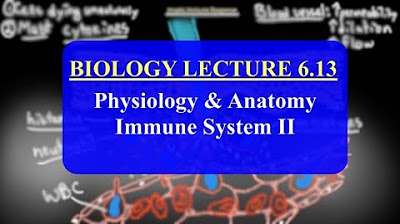CÉLULAS DO SISTEMA IMUNE - ENTENDA AS CÉLULAS DO SISTEMA IMUNE - IMUNOLOGIA (ABBAS)
Summary
TLDRIn this video, Kleberson continues his discussion on the immune system, focusing on innate immunity. He explains the role of basophils and mast cells, detailing their functions in immune responses and allergy reactions. The video also covers how the immune system identifies pathogens through molecular patterns called PAMPs and DAMPs, highlighting key receptors like Toll-like receptors, lectins, and N-formyl peptide receptors. These receptors activate inflammation pathways and play essential roles in pathogen recognition. Kleberson concludes with a preview of the next video, which will cover cytokines, crucial in immune responses.
Takeaways
- 😀 Basophils make up about 1% of white blood cells and contain histamine and other substances important for immune responses.
- 😀 Mast cells, involved in allergic reactions, release granules when activated to help fight infections and manage inflammation.
- 😀 Pattern Recognition Receptors (PRRs) in the immune system help distinguish between self and non-self cells, aiding in pathogen detection.
- 😀 PAMPs (Pathogen-Associated Molecular Patterns) are structures found on pathogens that allow the immune system to recognize them.
- 😀 DAMPs (Damage-Associated Molecular Patterns) are signals from damaged cells, helping the immune system respond to cellular stress or injury.
- 😀 Toll-like receptors (TLRs) are a type of PRR that play a crucial role in recognizing pathogens and initiating immune responses.
- 😀 Receptors like lectins identify carbohydrate structures on pathogens, helping the immune system target microorganisms.
- 😀 N-formyl peptide receptors, found on neutrophils, help detect bacterial peptides and activate immune cells to respond to bacterial infections.
- 😀 Cytokines are molecules that regulate inflammation and the immune response, playing a key role in communication between immune cells.
- 😀 The immune system uses a variety of receptors to identify pathogens, activate inflammation, and control the immune response through cascades of signaling events.
Q & A
What are basophils and what role do they play in the immune system?
-Basophils are cells in the innate immune system that make up about 1% of the leukocytes. They have a large, S-shaped nucleus and contain granules with substances like histamine, which are released during certain immune responses. Basophils are involved in inflammatory responses and can play a role in allergies.
What is the function of mast cells in the immune response?
-Mast cells are also part of the innate immune system and contain large amounts of granules in their cytoplasm. When activated, they release these granules, which are important in allergic reactions and defense against pathogens.
What are PAMPs and how do they help the immune system recognize pathogens?
-PAMPs, or Pathogen-Associated Molecular Patterns, are molecular structures found on pathogens like bacteria and viruses. These patterns help the immune system distinguish between the body's own cells and foreign invaders, triggering an immune response. Examples include peptidoglycan in Gram-positive bacteria and viral RNA.
What is the role of receptors in the innate immune system?
-Receptors in the innate immune system, such as Toll-like receptors, help identify PAMPs and DAMPs (Damage-Associated Molecular Patterns). These receptors are found on various immune cells like neutrophils and macrophages and help activate immune responses, such as inflammation and antimicrobial activity.
What are DAMPs and how do they differ from PAMPs?
-DAMPs, or Damage-Associated Molecular Patterns, are signals that the immune system uses to detect damaged or stressed cells in the body. Unlike PAMPs, which are specific to pathogens, DAMPs are associated with the damage or dysfunction of host cells.
What is the significance of Toll-like receptors in the immune response?
-Toll-like receptors (TLRs) are key components of the innate immune system. There are 11 types of TLRs, and they are found on cells like neutrophils, macrophages, and dendritic cells. These receptors help detect PAMPs and DAMPs, activating signaling pathways that lead to inflammation and immune defense mechanisms.
How does the immune system activate a response upon detecting pathogens?
-When receptors on immune cells detect PAMPs or DAMPs, they initiate a signaling cascade involving kinases, leading to the activation of pro-inflammatory pathways. This process helps the body mount a defense against pathogens or damaged cells.
What are the roles of cytokines in the immune response?
-Cytokines are small proteins that play a crucial role in inflammation and the immune response. They help modulate the activity of other immune cells, including promoting inflammation, attracting immune cells to sites of infection, and regulating immune cell differentiation and activation.
What are lectins and how do they contribute to the immune response?
-Lectins are receptors found on immune cells like macrophages and dendritic cells. They recognize carbohydrates present on pathogens, allowing immune cells to identify and respond to microbial threats. One example is the C-type lectin receptor, which binds carbohydrates in microbial cell walls.
Why are receptors like the N-formyl peptide receptor important in the immune system?
-The N-formyl peptide receptor is found on neutrophils and macrophages, where it recognizes formylated peptides, which are present in bacterial proteins. This helps the immune system target bacterial invaders and activate the appropriate immune response to clear the infection.
Outlines

This section is available to paid users only. Please upgrade to access this part.
Upgrade NowMindmap

This section is available to paid users only. Please upgrade to access this part.
Upgrade NowKeywords

This section is available to paid users only. Please upgrade to access this part.
Upgrade NowHighlights

This section is available to paid users only. Please upgrade to access this part.
Upgrade NowTranscripts

This section is available to paid users only. Please upgrade to access this part.
Upgrade NowBrowse More Related Video

Sistema Imunológico e Imunidade Inata | Anatomia etc

IMMUNOLOGY- Innate Immunity and Adaptive Immunity (FL-Immuno/01)

Immunology | Immune System: Overview

B CELLS and T CELLS EXPLAINED!

IMAT Biology Lesson 6.13 | Anatomy and Physiology | Immune System Part II

Imunologia veterinária - Imunidade inata (inespecífica)
5.0 / 5 (0 votes)